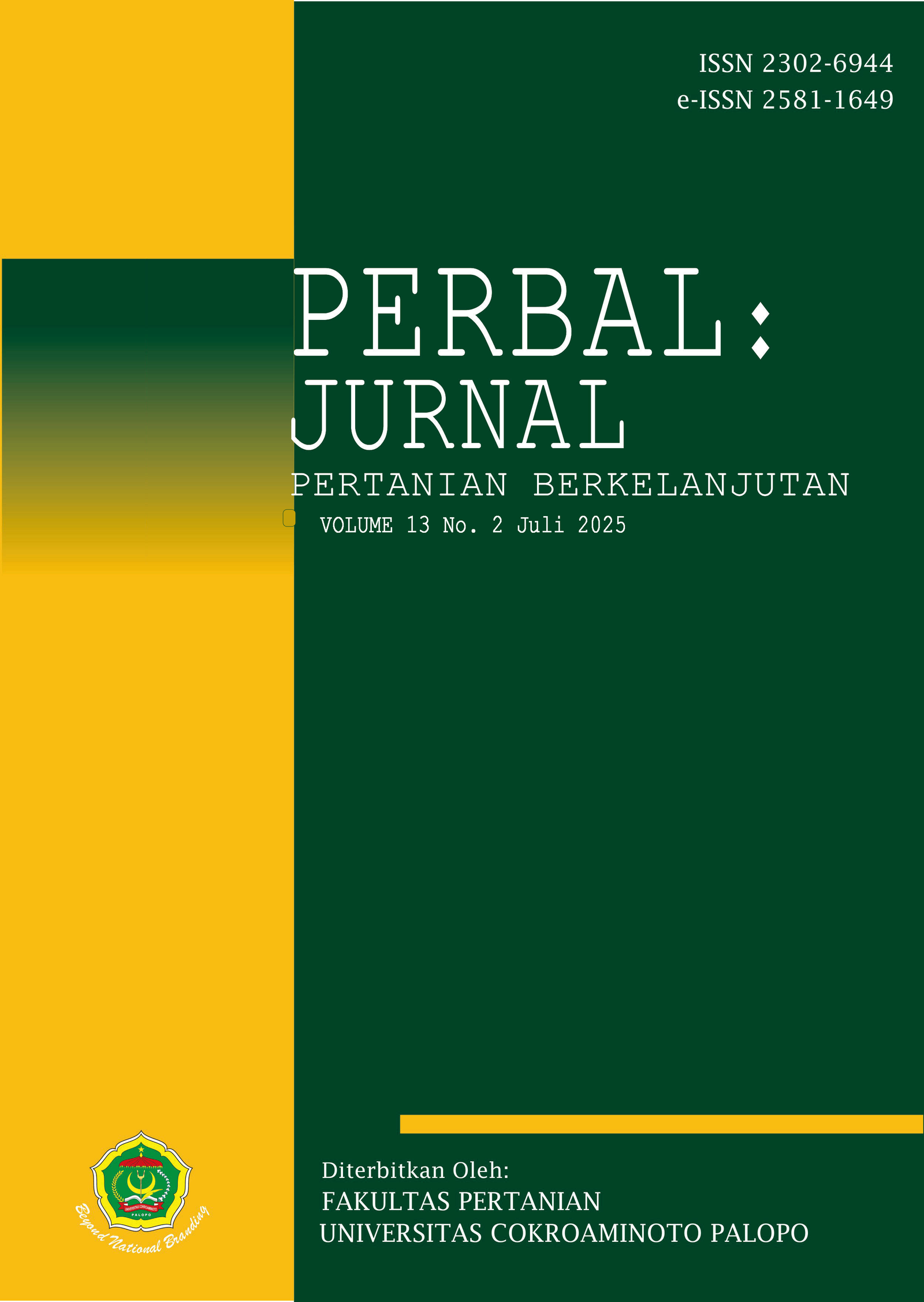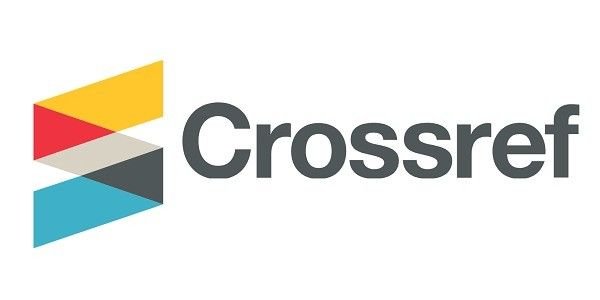Tingkat Bahaya Erosi Berbasis USLE, MUSLE, dan RUSLE dengan Penerapan SIG pada Lahan Pertanian di Provinsi Kalimantan Utara
Erosion Danger Levels Based on USLE, MUSLE, and RUSLE Models Using GIS Application on Agricultural Land in North Kalimantan Province
DOI:
https://doi.org/10.30605/perbal.v13i2.6370Keywords:
Erosi tanah, Kalimantan Utara, konservasi tanah, MUSLE, RUSLE, SIG, USLEAbstract
Erosi tanah merupakan salah satu permasalahan utama dalam pengelolaan lahan pertanian, terutama di wilayah dengan topografi kompleks seperti Provinsi Kalimantan Utara. Aktivitas pertanian yang tidak diimbangi dengan praktik konservasi tanah yang baik dapat meningkatkan risiko kehilangan lapisan tanah atas yang subur. Penelitian ini bertujuan untuk mengidentifikasi dan memetakan tingkat bahaya erosi pada berbagai jenis tutupan lahan pertanian dengan pendekatan tiga model empiris utama: Universal Soil Loss Equation (USLE), Modified USLE (MUSLE), dan Revised USLE (RUSLE). Ketiga model ini diterapkan dengan dukungan Sistem Informasi Geografis (SIG) untuk menghasilkan distribusi spasial laju erosi secara akurat. USLE menghitung kehilangan tanah tahunan berdasarkan faktor-faktor seperti intensitas curah hujan, erodibilitas tanah, panjang dan kemiringan lereng, tutupan lahan, serta praktik konservasi. MUSLE memperhitungkan volume limpasan permukaan, sementara RUSLE menyempurnakan faktor-faktor curah hujan dan penutup lahan. Hasil analisis menunjukkan bahwa lahan kering pada lereng curam yang dikelola tanpa konservasi memiliki tingkat erosi tertinggi. Sebaliknya, lahan sawah dan lahan rawa menunjukkan tingkat erosi sangat rendah, terutama karena sistem irigasi dan kondisi permukaan tanah yang lebih stabil.
Soil erosion is one of the major challenges in agricultural land management, especially in areas with complex topography such as North Kalimantan Province. Agricultural activities that are not supported by proper soil conservation practices can lead to significant loss of the fertile topsoil layer. This study aims to identify and map the level of erosion risk across various types of agricultural land cover using three main empirical models: the Universal Soil Loss Equation (USLE), the Modified USLE (MUSLE), and the Revised USLE (RUSLE). These models are applied with the support of Geographic Information Systems (GIS) to produce accurate spatial distributions of erosion rates. The USLE model estimates annual soil loss based on factors such as rainfall intensity, soil erodibility, slope length and steepness, land cover, and conservation practices. The MUSLE model incorporates surface runoff volume into its calculations, while the RUSLE model refines the rainfall and land cover factors. The analysis reveals that the highest erosion rates occur on dry agricultural lands located on steep slopes with minimal conservation measures. In contrast, paddy fields and swamp lands tend to exhibit very low erosion rates, largely due to the presence of irrigation systems and more stable soil surface conditions.
Downloads
References
Aldrian, R., & Sidiq, M. (2023). Soil erosion assessment using RUSLE and GIS in dryland agricultural areas in Indonesia. Indonesian Journal of Geography, 55(1): 45–56.
Arsyad, S. (1989). Konservasi Tanah dan Air. IPB Press. Bogor.
Asdak, C. (1995). Hidrologi dan Pengelolaan Daerah Aliran Sungai. Gadjah Mada University Press. Yogyakarta.
Devatha, C. P., Deshpande, V., & Patil, A. (2020). Estimation of soil erosion risk using RUSLE model using remote sensing and GIS: A case study. Heliyon, 6(3): e03087.
Fitriani, N., Siregar, A. M., & Rahim, S. E. (2019). Pengaruh penggunaan lahan terhadap erosi di DAS Sub Cianten. Jurnal Geografi, 11(1): 11–20.
Handayani, L., Suryani, I., & Sari, Y. (2018). Evaluasi tingkat erosi pada berbagai penggunaan lahan menggunakan RUSLE. Jurnal Ilmu Tanah dan Lingkungan, 20(2): 95–102.
Junaidi, A. (2017). Penggunaan Lahan dan Konservasi Sumber Daya Lahan. Penebar Media. Jakarta.
Lanyala, A., Hasanah, U., & Ramlan, A. (2016). Pengaruh perubahan penggunaan lahan terhadap potensi erosi. Jurnal Sains Tanah dan Agroklimat, 13(1): 33–42.
Lutfi, R. A. (2007). Tata Guna Lahan dan Perencanaan Wilayah. Pustaka Pelajar. Yogyakarta.
Mansyur, H. (2019). Pengaruh tekstur dan permeabilitas tanah terhadap tingkat erosi di lahan pertanian. Jurnal Agroteknologi Tropika, 7(1): 15–22.
Marhendi, D., & Iskahar, R. (2017). Pengaruh kemiringan lereng terhadap tingkat erosi pada lahan pertanian. Jurnal Ilmu Lingkungan, 15(2): 45–54.
Rahman, M. M., & Hossain, M. L. (2019). Application of RUSLE model using GIS and remote sensing techniques to estimate soil loss for soil conservation planning in Chittagong Hill Tracts, Bangladesh. Modeling Earth Systems and Environment, 5(2): 1–15.
Ramdani, R. (2020). Klasifikasi lereng dan potensi erosi di Kalimantan Utara. Jurnal Tanah Tropika, 25(1): 23–30.
Suripin. (2001). Pelestarian Sumber Daya Tanah dan Air. Andi Offset. Yogyakarta.
Suripin. (2002). Erosi dan Konservasi Tanah. Penerbit Kanisius. Yogyakarta.
Zhang, G. H., Liu, B. Y., Zhang, X. C., & Nearing, M. A. (2020). Erosion modeling using USLE, RUSLE, and MUSLE under different cropping systems in China. Soil & Tillage Research, 199: 104577.
Downloads
Published
Issue
Section
License
Copyright (c) 2025 Deny Titing, Nur Indah Mansyur, Eko Hary Pudjiwati

This work is licensed under a Creative Commons Attribution 4.0 International License.
In submitting the manuscript to the journal, the authors certify that:
- They are authorized by their co-authors to enter into these arrangements.
- The work described has not been formally published before, except in the form of an abstract or as part of a published lecture, review, thesis, or overlay journal.
- That it is not under consideration for publication elsewhere,
- That its publication has been approved by all the author(s) and by the responsible authorities – tacitly or explicitly – of the institutes where the work has been carried out.
- They secure the right to reproduce any material that has already been published or copyrighted elsewhere.
- They agree to the following license and copyright agreement.
License and Copyright Agreement
Authors who publish with Onoma Journal: Education, Languages??, and Literature agree to the following terms:
- Authors retain copyright and grant the journal right of first publication with the work simultaneously licensed under Creative Commons Attribution License (CC BY 4.0) that allows others to share the work with an acknowledgment of the work's authorship and initial publication in this journal.
- Authors are able to enter into separate, additional contractual arrangements for the non-exclusive distribution of the journal's published version of the work (e.g., post it to an institutional repository or publish it in a book), with an acknowledgment of its initial publication in this journal.
- Authors are permitted and encouraged to post their work online (e.g., in institutional repositories or on their website) prior to and during the submission process, as it can lead to productive exchanges, as well as earlier and greater citation of published work.














